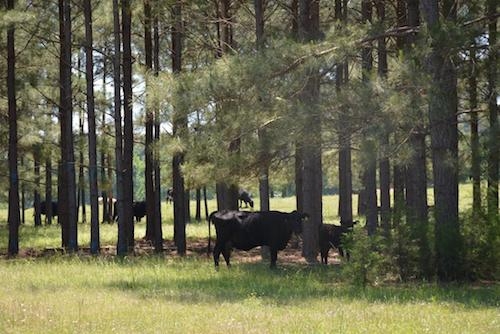
Stephen F. Austin State University’s Arthur Temple College of Forestry and Agriculture is establishing a silvopasture demonstration area, which combines the production of trees with an understory component of forage for livestock, at the Walter C. Todd Agricultural Research Center. The demonstration area also provides environmental and financial benefits.
June 8, 2020 — Thanks to a Conservation Innovation Grant from the Natural Resources Conservation Service, Stephen F. Austin State University’s Arthur Temple College of Forestry and Agriculture is moving forward with the establishment of a silvopasture demonstration area at the Walter C. Todd Agricultural Research Center.
“Silvopasture is an agroforestry practice that combines the production of trees with an understory component of forage for livestock,” said Jason Grogan, research associate with the Arthur Temple College of Forestry and Agriculture.
Grogan explained that the system provides myriad benefits, including soil protection, carbon sequestration and improved weight gain in cattle during the hot summer months, as well as overall efficiency in land utilization.
The combination of long-term income from timber sales along with annual income from livestock production can be economically beneficial to producers — especially those with relatively small acreage tracts.
The demonstration area is unique in that it will provide landowners with insight into transitioning to a silvopasture system from a heavily forested area, as well as from bare pastureland.
Currently, Grogan is overseeing the thinning of a dense pine plantation to create open rows in which native grasses will be planted for livestock forage. In an adjacent area without trees, brush will be cleared to allow for the planting of native grasses and loblolly pines.
Grogan said pines will be planted in groups of three rows with a 30-foot gap between each grouping. In addition to space for grazing, this gap also will allow hay to be baled.
“The area we’re converting from bare pasture to silvopasture will have to remain free of livestock for about three years until the pine trees are large enough to not be damaged by livestock,” Grogan said.
Although the area will heavily focus on demonstration and outreach, Grogan said there will be opportunities for research.
“We’re hoping to look at the efficiency of using goats to control woody vines and vegetation rather than herbicide when converting a forest to silvopasture,” Grogan said.
Landowners interested in learning more about this agricultural system won’t be the only beneficiaries of the new demonstration area — the SFA cattle herd also will graze there.
A public field day is tentatively scheduled for January. For more information on silvopasture or the demonstration area, contact Grogan at (936) 468-5588 or jgrogan@sfasu.edu.
Story by Sarah Fuller, outreach coordinator for Stephen F. Austin State University’s Arthur Temple College of Forestry and Agriculture. Contact information: (936) 468-1185 or fullersa@sfasu.edu.









